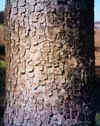 |
|
Courtesy G. Lumis |
Just as human beings have a protective outer layer all over their bodies known as skin, so do trees have a protective outer layer called bark. Damage to the bark can prove fatal to the tree. If someone cut the bark, around a tree to the wood beneath the flow of food would be disrupted and the tree will starve to death.
Many kinds of trees can be immediately recognized by their distinctive bark. Variations in markings, colour and texture denote not only the type of tree, but even the age of the tree within that particular species.
The bark of a young tree and that on young parts of a mature tree are quite thin, but the bark of an older tree is thick and rough. For instance the bark of the giant and ancient west-coast Douglas-fir tree, may be more than a foot thick.
Every tree has two layers of bark, an inner layer and an outer layer. The inner bark, through which food passes up and down he trunk and along the branches, is soft and moist. The outer bark is hard and firm. The hardness and thickness of the bark protects the tree from injury and from the elements.
The older the tree, the thicker the bark grows. This is because each year a layer of inner bark hardens and becomes part of the outer bark. In this way the outer bark builds off, even though some of it will eventually fall off the tree in the form of scales.

